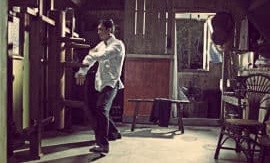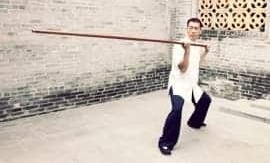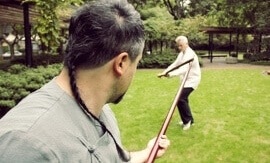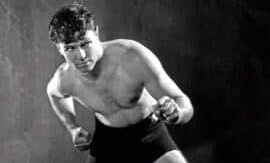
I BELIEVE IN PRESSURE TESTING AND THE FACT THAT IT MAKES A DIFFERENCE IN YOUR ABILITY TO REACT PROPERLY. YOU KNOW ABOUT CHI SAU, BUT THAT IS NOT THE PRESSURE I’M TALKING ABOUT.
I am talking about pressure from an assailant keeping you pinned against a wall whether by strikes, shoulder pressure, or from repeated aggressive shoving. I’m talking about conditioning and training your strikes to hit with power against heavy bags, wall-bags, focus mitts and kick shields.
How strong is your strike really? Can it stop an assailant and do some damage? When someone is moving, countering and making you uncomfortable, the mental and physical pressure is very different from Chi Sau.
When we watch our brothers take on an assailant from another martial art, how do they fair? What does it say about our training and capability when those that fly our flag can’t fight? How do we change that for the next generation?
As I watch Chinese martial arts get challenged, in front of streaming and live recordings, by Muay Thai, Jiu-jitsu and MMA to full-contact fights, I ask myself, what am I doing to prepare my students and myself for a real confrontation?
Testing reactions and reflexes is already a key part of so many Wing Chun lineages. Though the drills and intensity may change and the reasons behind the training may differ from one another, one thing always remains—the power, endurance and accuracy behind the strike remain constant.
However, the absence of pressure testing makes a huge difference. I have had students come to my studio with 7-20+ years of background in Wing Chun who had a hard time striking mitts and heavy bags properly, repeatedly and with fighting endurance. Many did their forms beautifully and could work the Wooden Dummy with good flow, yet had a hard time sparring against a non-compliant practitioner.
Let’s look at these four areas regarding the absence of pressure and how to fix it.
In our school, we have people that have had major years and training in other styles from Krav Maga, Taekwondo, Muay Thai and Karate, to name but a few. So, to put it simply, we have a time where we spar every week and one person is good (uses only Wing Chun) and the aggressor is bad (uses whatever previous style they trained in). Thus, the Wing Chun practitioner goes for rounds with different styles and different partners before switching.
In each match, the student is increasing their capability to deal with different pressures of attacks while breaking mental barriers that cause fear in facing someone new. We also encourage our students to video themselves in order to look back and see what they are doing wrong, and how they can change this. Once they get to a certain level, we suggest that they go out and get together (respectfully) with other styles and spar with them. This can be done through a friendly exchange, tournaments, full contact Sanda, or event Kickboxing and Muay Thai matches for those interested.
Directional pressure is just that—don’t overthink it. Imagine you’re moving around with your partner in a friendly sparring match and you are wearing open palm gloves. In the midst of your bout you “push-check” their shoulder or their ribs. Did they get knocked to the side or did they root and stay their ground? You “push-check” them back to see their stability and reaction, did they root? Great! That’s awesome; they didn’t fall, but they also didn’t immediately counter-attack after catching their balance. It’s the details that show us where we are weak and where still have work to do.
Take this other scenario, as you move with your partner and pull them, do you notice their weight shifting backward or forward? Or, did they immediately root inward and attack, or did they fall forward? We test directional pressure for one big reason; attacks can jar you, even if you try to redirect them. They can jar your entire structure but training to deal with directional pressure can save you. What if your student faces these, will they be able to move in and keep great balance or just “hope” that they will? Don’t hope it will work— training directional pressure makes it work!
Pressure can come in many forms. From your partner pushing your shoulders or centre of the chest (centre mass) to seeing if you shift and redirect. This is testing your ability to apply directional and reactionary pressure from your assailant.
Directional reactionary training also comes in the form of single- and double-hand Chi Sau and Bong Lop partner training. However, the more dynamic your ability to train, the more prepared you may be for what is coming.
One of my teachers used to say, “Are you afraid of your punch?” In essence, if you got hit by that punch you just threw, would it frighten you to get hit by it again? If you have ever gotten punched or kicked by a heavy hitter in a fight, you know you’re thinking about that attack coming again. This type of pressure can allow a practitioner to set up and change follow-ups because FEAR has been instilled. The question then becomes if your student is faced with this type of attack, concern, or fear, will they have trained to overcome it or to succumb to it?
If each punch you throw won’t knock them out, why did you even throw it? Was it to jar them, set them up, or just piss them off? Hard punches are more than just hitting some rice bags on a wall. Your conditioning and training should be like any fighter; it is your style that is different. If I take a guy that conditions like a boxer, Muay Thai or MMA and teach them Wing Chun, you don’t think they would rock some amazing devastation? Pressure training your joints for angled strikes and the endurance to throw them will make a huge difference. Shadowbox the heavy bag with everything you have, then, like a boxer, get in front of a friend that really knows how to hold mitts and have them hold for you, move for you, and even attack you to see where you’re open and how well you are at closing distance, following up and overcoming the pressure of resistance training, attacks and simultaneous movement.
Here’s a routine we use in-house that will give you more reactionary power. You can increase the time and pressure the more you do it. Perform five, three-minute rounds on a heavy bag and five, three-minute sparring rounds. Have someone record you or set up your phone to take video. Then, review the footage and ask yourself where you are and where do you want to be. Set some goals for yourself, whether it is more power, ferocity, or reaction to attacks.
Some may say Wing Chun isn’t made for an MMA face-to-face conflict or that Wing Chun isn’t for the cage, but isn’t that limiting ourselves? How exactly can training to proficiently fight MMA, Muay Thai and other combat styles using Wing Chun be bad?
The conditioning, timing and experience you gain doing so can only improve your Wing Chun. This enables you to train for better endurance, smarter reaction, quicker timing and a more sound understanding of where you are in your Wing Chun journey. How is that bad for Wing Chun and how is that bad for you? The answer? It’s not! Train like a fighter because one day you might be against one.
What if your student is up against more than one person and they can’t run because their family is in danger, is their cardio up to the task? Remember that your power and technique drop as you exhaust yourself, so it does make a difference. That’s why even well-trained and great practitioners can be seen throwing inaccurate strikes, wild hooks, and holding when exhaustion sets in.
Train them to go against other styles inside of your own school, and against your own students, which pressure tests their understanding and application of what you are teaching.
Wing Chun got well known because people such as Ip Man, Wong Shun Leung, Bruce Lee, and those fighters of the art, kept pushing the bar of what they were capable of USING within the art of Wing Chun, not restricting.



















